


IUCr Congress
Wall to Wall Crystallographers at the XVI IUCr Congress
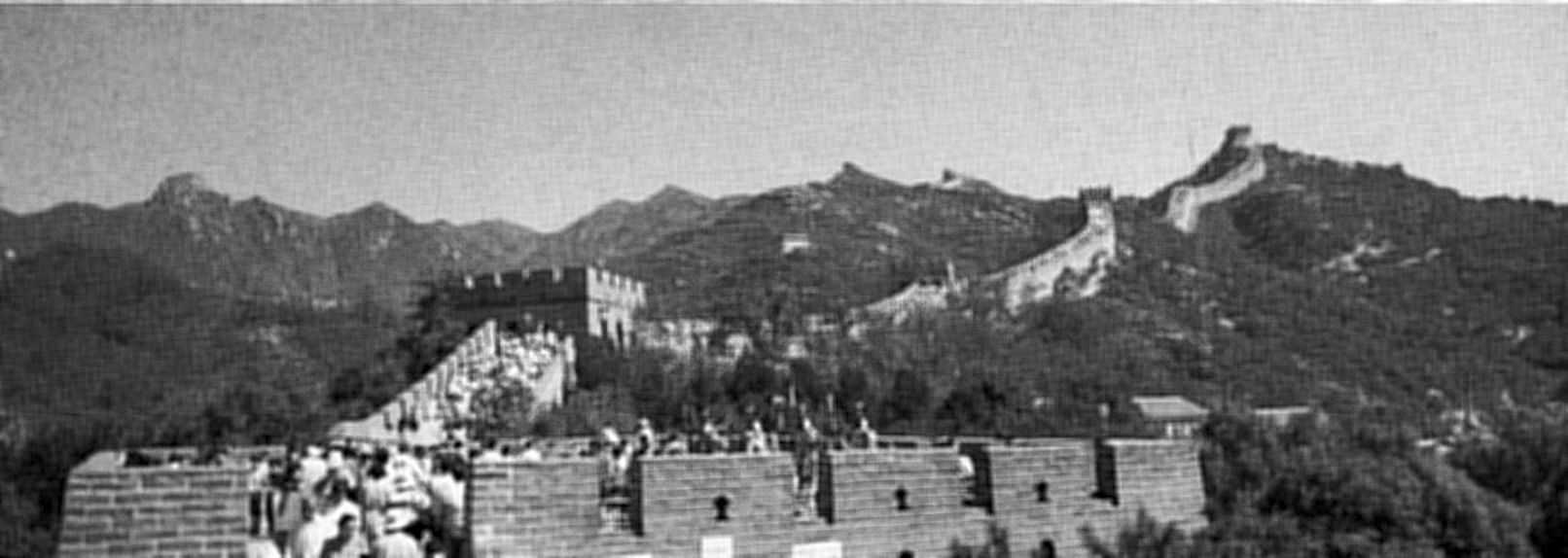
The scientific program of the Crystallographic Congress in Beijing was extraordinarily rich and varied. The 18 plenary lectures, 370 oral presentations in microsymposia, discussion sessions, and open commission meetings, and 655 poster presentations, clearly illustrated how crystallography touches every aspect of our daily lives.
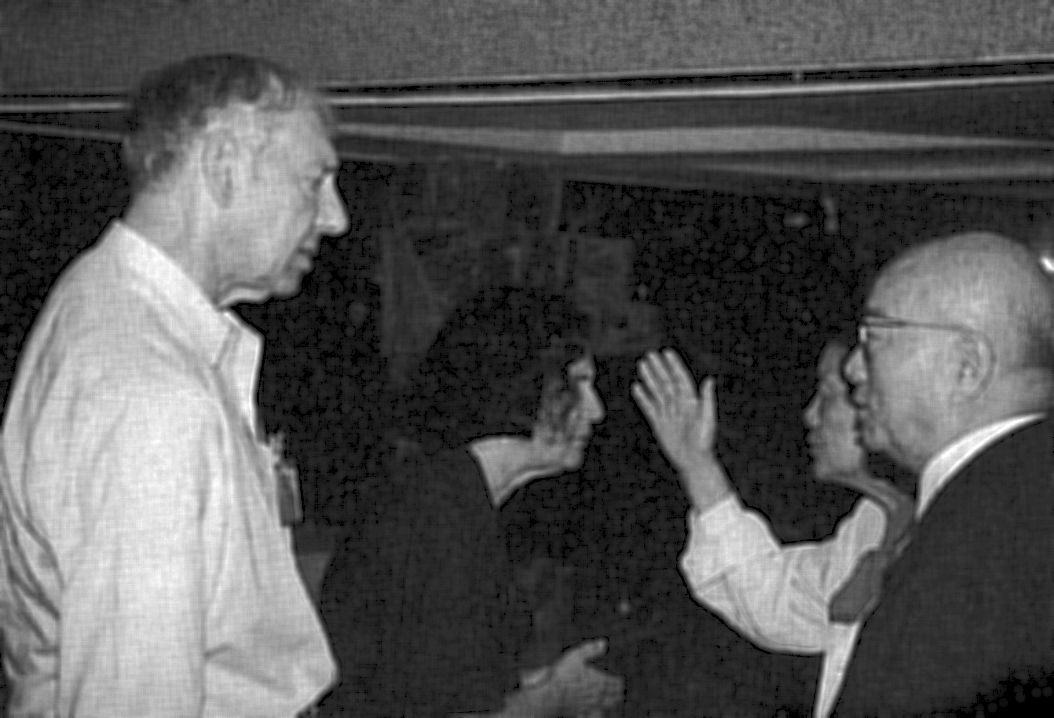 M. Woolfson (UK) and his wife visit with Y. Tang (PRC) and his wife at the opening reception. It was Prof. Tang's leadership and determination that brought the crystallographic community to China at this time of exceptional scientific growth and development. Prof. Woolfson was one of the early champions of Chinese science and a strong advocate for holding the 1993 IUCr meeting in China.
M. Woolfson (UK) and his wife visit with Y. Tang (PRC) and his wife at the opening reception. It was Prof. Tang's leadership and determination that brought the crystallographic community to China at this time of exceptional scientific growth and development. Prof. Woolfson was one of the early champions of Chinese science and a strong advocate for holding the 1993 IUCr meeting in China.
In Table 1, the Categories of the program are listed in the order of decreasing numbers of contributions recorded in the Book of Abstracts. This sequence reflects the amount of research done in the various fields of crystallography. If the Categories are arranged into the groups: methods (M), states of matter (S), biological materials (B), organic materials (O), inorganic materials (I), and other topics (oT), see Table 1, and if the categories belonging to two of these groups are equally allotted to the two corresponding groups to form the extended groups of Table 2, it becomes evident that the numbers of the submitted contributions dealing with methods (23.9%), biological materials (22.5%), and inorganic materials (21.6%) are nearly equal and about twice as high as the contributions dealing with states of matter (12.3%) and organic materials (12.0%). To obtain an estimation of the quotae of contributions dealing with (i) inorganic substances plus minerals, and (ii) organic and biological substances, respectively, F. Liebau (Germany) added to the corresponding contributions of Table 2 those contributions of the extended groups M, S, and oT, which according to their abstracts deal with substances belonging to class (i) or class (ii), and assigned the organometallic and coordination compounds to (i) as well as to (ii). As a result, of the 1259 contributions contained in the Book of Abstracts, 44% deal with inorganic substances and minerals and 46% organic and biological materials.
| Numbers of | |||||||
|---|---|---|---|---|---|---|---|
| Category | Main lectures | Invited lectures | Posters | Σ | % | Rank | Groups |
| 3 Biol. Macromolecules | 3 | 52 | 138 | 193 | 15.3 | 1 | B |
| 7 Organomet., Coord. Comp. | 1 | 13 | 104 | 118 | 9.4 | 2 | I/O |
| 8 Inorg., Minerals | 1 | 17 | 92 | 110 | 8.7 | 3 | I |
| 2 Methods | 1 | 42 | 52 | 95 | 7.5 | 4 | M |
| 6 Organic Compounds | 1 | 11 | 80 | 92 | 7.3 | 5 | O |
| 10 Structure/Propertles Relat. | 2 | 11 | 55 | 68 | 5.4 | 6 | I |
| 12 Amorph., Disord., Quasicryst. | 1 | 23 | 43 | 67 | 5.3 | 7 | S |
| 4 Biol. Small Molecules | 1 | 21 | 43 | 65 | 5.2 | 8 | B |
| 11 Surfaces, Thin films | 1 | 12 | 48 | 61 | 4.8 | 9 | S |
| 1 Instrument., Exp. Techn. | 3 | 31 | 25 | 59 | 4.7 | 10 | M |
| 13 Defects, Textures | - | 12 | 43 | 55 | 4.4 | 11 | I/S |
| 21 Non-Ambient P/T, Phase Transitions | - | 23 | 30 | 53 | 4.2 | 12 | oT |
| 5 Protein and Drug Design | 1 | 16 | 32 | 49 | 3.9 | 13 | M/B |
| 14 Diffr. Physics, Optics | - | 10 | 33 | 43 | 3.4 | 14 | M |
| 15 Crystal Growth | - | 6 | 27 | 33 | 2.6 | 15 | M |
| 18 Data Bases, Communications | - | 21 | 5 | 26 | 2.1 | 16 | M |
| 20 Industrial Crystallography | 1 | 13 | 3 | 17 | 1.4 | 17 | oT |
| 19 Teaching, History | - | 6 | 10 | 16 | 1.3 | 18 | oT |
| 9 Engin., Comput. Simul. of Inorganic Structures | 1 | 7 | 6 | 14 | 1.1 | 19/20 | I/M |
| 16 Methods other than Diffract. | - | 6 | 8 | 14 | 1.1 | 19/20 | M |
| 17 Symmetry | - | 7 | 4 | 11 | 0.9 | 21 | oT |
| Σ | 18 | 360 | 881 | 1259 | |||
Table 1: Contributions recorded in the Book of Abstracts for the 21 Categories, arranged in the order of decreasing number of contributions (F. Liebau,Germany).
| Extended group | Contrib. (%) | Rank |
|---|---|---|
| M | 23.9 | 1 |
| B | 22.5 | 2 |
| I | 21.6 | 3 |
| S | 12.3 | 4 |
| O | 12.0 | 5 |
| oT | 7.8 | 6 |
Table 2: An extended group contains the contributions of the corresponding groups (last column of Table 1) plus 50 percent of the contributions assigned to this group as well as to another group.
The following comments on the plenary lectures and the content of the microsymposia are drawn from reports provided by the majority of the chairpersons. Numbers in parenthesis refer to sessions in the categories of Table 1.
Instrumentation
In his plenary lecture concerning Third Generation X-Ray Synchrotron Sources (1.01), J. Als-Nielsen (France) described the special properties and potential of the TROIKA beam at ESRF in Grenoble. Among the first applications described were an elucidation of docking sites in seryl-tRNA synthetase, and the examination of the packing of mono layers of short chain acids over water. Chair F. Liebau
Time-Resolved Structural Studies (1.01) are now common in macromolecular crystallography, EXAFS, muscle diffraction, and powder diffraction. Synchrotron radiation has greatly extended the time resolution achievable. Previous feasibility studies indicated that time resolutions as short as 120 picoseconds (ps) could be realized. In his main lecture, K. Moffat (USA) reported the measurement of complete data sets on photoactive yellow protein both before and 20 milloseconds (ms) after initiating decay from a photo stationary state. By means of a "two spot" Laue technique, and individual exposures of 30 ms, data sets on a very fast time scale were achieved. In other sessions the application of Laue and monochromatic techniques were reported on several enzymes including phosphorylase (L. Johnson, UK), trypsin (R. Sweet, USA), and haloalkane dehalozenase (B. Dijkstra, The Netherlands). J. Helliwell (UK) reported developments at Daresbury with the Laue method, including use of image plates, and a large-angle oscillation technique (LOT) with monochromatic SR. A. Fontaine (France) reported on very fast EXAFS techniques and a quick scanning approach (QEXAFS) applied to a variety of chemical systems. E. Towns-Andrews (UK) described the muscle system and measurements of two-dimensional fiber diffraction patterns on the ms time scale. W. Depmeier (Germany) described reaction and pressure cells for the control of sample properties and environment for in situ diffraction experiments. Y. Ohashi (Japan) presented a new type of diffractometer for quick data collection for chemical structure studies. Finally, Å. Kvick (France) reported the first Laue diffraction from a protein crystal recorded at the European Synchrotron Radiation Facility (ESRF) and work with M. Wulff (France) to realize microsecond time resolution on a new instrument there. Chair J. Helliwell
An open meeting of the IUCr Commission on Crystallographic Apparatus on Developments and Directions in Crystallographic Instrumentaion (1.03) covered a broad range of subjects. Y. Amemriya (Japan) illustrated his talk on the development of new TV detectors for X-ray analysis with time-resolved diffraction patterns of Small Angle X-Ray Scattering (SAXS) from contracting muscle. The relative merits of counting and integrating detectors were compared by R. Lewis (UK). The exciting, newly emerging techniques of Diffraction Anomalous Fine Structure (DAFS) and Diffraction Anomalous Near Edge Structure (DANES) were introduced by L. Sorensen (Australia). The marriage of diffraction and XAFS permits simultaneous determination of spatial and site specific data. Sorensen illustrated his talk with data from thin crystals of copper and 123 superconductors. For the superconductors he showed how the information from the two copper sites could be determined. Other speakers described the use of Mössbauer spectroscopy (G. Stewart, Australia), white beam synchrotron radiation (K. Ohsumi, Japan), and resonant nuclear scattering (J. Arthur, USA) to study materials ranging from ceramics to meteorite fragments.
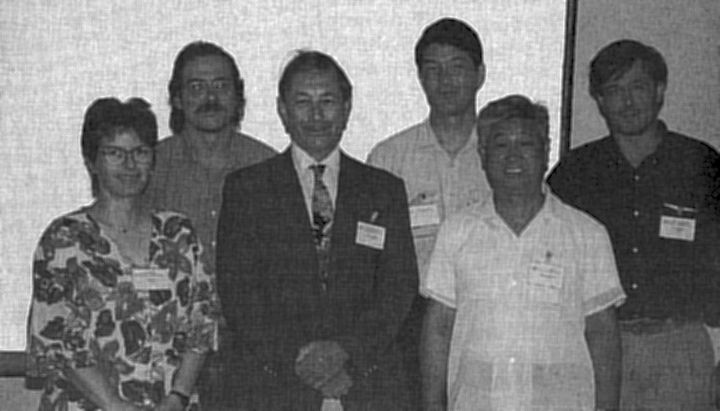 Speakers from the microsymposium on Magnetic Scattering (1.04) (from left), S. Stahler (Germany), G. Grübel (France), M. Blume (USA), H. Kawata (Japan), Z. J. Ge (PRC), C. Vettier (France).
Speakers from the microsymposium on Magnetic Scattering (1.04) (from left), S. Stahler (Germany), G. Grübel (France), M. Blume (USA), H. Kawata (Japan), Z. J. Ge (PRC), C. Vettier (France).
A microsymposium on Magnetic Scattering (1.04) illustrated the critical importance of the complementarity of X-ray and neutron scattering measurement and featured talks on resonant magnetic scattering (M. Blume, USA), magnetic critical X-ray scattering in rare earth and actinides (D. Gibbs, USA) and polarization analysis (G. Grubel, France). Session chair C. Vettier (France) notes that the magnetic scattering experiments conducted at synchrotron X-ray sources require careful sample preparation and high quality crystals.
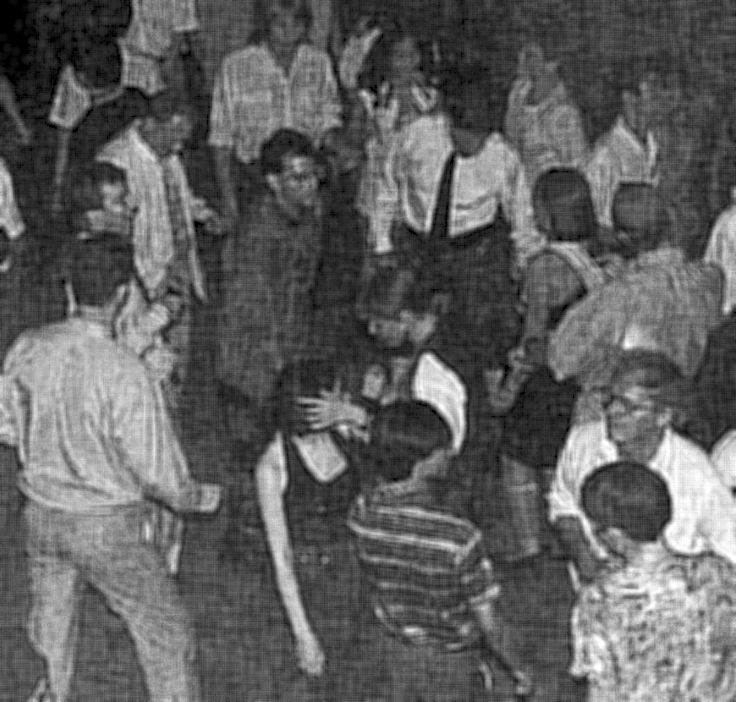 Microsymposium 1.07 Disco: New Techniques.
Microsymposium 1.07 Disco: New Techniques.
A microsymposium on dancing, Disco: New Techniques (1.07), a tradition of crystallographic meetings was well attended. Led by Fusen Han, over 50 meeting attendees descended on a Beijing bistro to dance to the beat of rock and roll, waltz, and disco music. Among the participants were future congress organizers W. L. Duax and R. Bryan (Seattle 1996) and C. Gilmore and J. Howard (Glasgow 1999) who took note of the success of the event. The younger, more resilient participants included a British delegation led by Chick Wilson, Jason Cole, Nigel Pitchford, Richard Pauptit, and Claire (Wilson?) The highlight of the session came directly from the Highlands with Chris Gilmore rocking and rolling - in full Scottish attire. Chair, S. Fortier (Canada)
The production of a 0.1mm diameter X-ray beam (D. Bilderback, USA), the use of T B66 as a soft X-ray monochromator for the 1-2 keV region (Z. Rek, USA), and the extraordinary range of polarizations achievable by crystal optics (L. Ishikawa, Japan) were among the impressive accomplishments discussed in the microsymposium on X-Ray Optics for Synchrotron Radiation (14.01). Chair T. Matsushita (Japan)
 "From this Chinese sign for water, it is evident that thousands of years ago, the Chinese had unraveled the structure and electron density of the water molecule. Note the O-H bonds, the oxygen lone pairs, and there is even a C2 axis indicated." K. Hermansson from her talk on positive and negative sides of charge determination.
"From this Chinese sign for water, it is evident that thousands of years ago, the Chinese had unraveled the structure and electron density of the water molecule. Note the O-H bonds, the oxygen lone pairs, and there is even a C2 axis indicated." K. Hermansson from her talk on positive and negative sides of charge determination.
Methods of analysis
The use of maximum entropy-likelihood to identify the correct phase solution for avian pancreatic polypeptide produced by Woolfson's SAYTAN formula (C. Gilmore, UK) and a report of the first ab initio direct methods phase determination of crambin (C. Weeks, USA) by Hauptman's minimal function were highlights of a session on Direct Methods of Phasing Macromolecular Structures (2.01). These protein structures were previously determined by traditional isomorphous replacement techniques. Session co-chair S. Fortier (Canada) concludes that the success achieved by combining direct methods, density modification, and other techniques suggests that by the 1996 IUCr meeting, ab initio "direct methods" determinations of a previously unphased protein structure will be reported.
In commenting on the microsymposium on ab initio Structure Determination from Powder Data (2.03) session Chair C. Gilmore (UK) cited no single spectacular result but a growing confidence in terms of the size and complexity of structures that can be tackled.
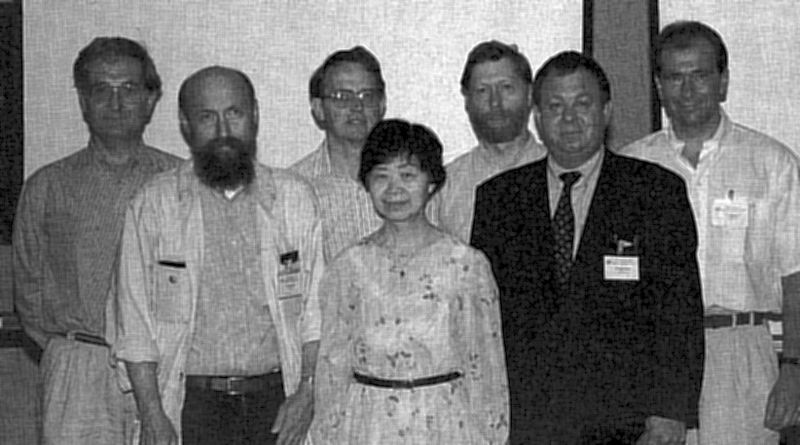 Speakers in the microsymposium on Direct Phasing for Electron Diffraction Data (2.04), (from left) J. W. Steeds (UK), D. Dorset, Chair (USA), S. Hovmöller (Sweden), F. H. Li, Co-chair (PRC), C. Gilmore (UK), D. van Dyck (Belgium), and J. Mayer (Germany).
Speakers in the microsymposium on Direct Phasing for Electron Diffraction Data (2.04), (from left) J. W. Steeds (UK), D. Dorset, Chair (USA), S. Hovmöller (Sweden), F. H. Li, Co-chair (PRC), C. Gilmore (UK), D. van Dyck (Belgium), and J. Mayer (Germany).
A micro symposium on Direct Phasing from Electron Diffraction Data (2.04) revealed that ab initio crystal structure determination is achievable using electron diffraction data by creating experimental conditions that yield quasi-kinematical data or exploiting dynamical scattering effects. Session highlights were demonstrations that small molecule structures can be solved by symbolic addition or tangent formula manipulation of phase invariants (D. L. Dorset, USA) or application of maximum entropy methods (C. J. Gilmore, UK), quantitative analysis of inorganic structures using data from higher order Laue zones (J. W. Steeds, UK), improved resolution of electron microscope images of incommensurate phase structures (F. H. Li, PRC), elucidation of metal oxide film structure by image processing of high resolution electron micrographs (S. Hovmöller, Sweden), and use of dynamical scattering to experimentally evaluate E1 and E2 triples for highly accurate phase determination via convergent beam electron diffraction (J. Mayer, Germany). Finally, D. van Dyck (Belgium) described scattering theory limitations for obtaining interpretable atomic resolution images of crystals. Chair D. Dorset (USA)
Highlights of the microsymposium on Phasing and Refinement of Macromolecular Structures (2.07) included comparison of several models of bulk solvent and thermal motion in protein crystals (A. T. Brunger, USA), the combined use of solvent flattening and maximum entropy/likelihood methods to solve protein structures (C. Carter, USA), comparison of various real and reciprocal space constraints using the program SQUASH (K. Y. J. Zhang, USA), and new criteria to evaluate the potential success of application of direct methods to macromolecules (G. Giacovazzo, Italy). The most startling presentation was J. Clarage's report that observed diffuse scattering of myoglobin is incompatible with motion obtained from molecular dynamics simulations. Session Chair A. T. Brunger predicts that the combination of different techniques (solvent flattening, maximum entropy, histogram matching, etc.) will lead to further improvements in phase refinement.
Macromolecular studies
Seven main lectures, 17 microsymposia, seven discussion sessions and workshops, five open commission meetings, and more than 25 poster sessions and subsessions on Macromolecular Structure and its Determination (3.00), all this in seven full days of meetings - a wealth of new science, a challenge to audit. Not a moment without a macromolecular presentation somewhere, more often than not simultaneous macromolecular presentations for most of the day. No person could attend everything, but then no article could do justice to all that was noteworthy at this meeting. The main lectures were particularly rewarding; presentations by K. Moffat (USA) on time resolution methods on the first day and by M. James (USA) on hydrolytic mechanisms in the proteinases and beta-lactamases on the last bracketing others by M. Rossmann (USA) on viral structure and infectivity, L. Johnson (UK) on structure-based drug design with particular reference to phosphorylase inhibitors, T. Blundell (UK) on the role of crystallography in biotechnology, and A. Yonath (Israel) on ribosome structure.
 After Louise Johnson's (UK) (left) masterful plenary lecture on Structure Based Drug Design in which she surveyed everything from the earliest known herbal medicines through several dozen examples of the use of protein crystal structure analysis to develop, design, and improve therapeutic agents, she spoke with Dorothy Hodgkin (right) who made it abundantly clear to her daughter Lizzie (center) that attending Louise's talk was one of Dorothy's highest priorities during the ten-day Congress.
After Louise Johnson's (UK) (left) masterful plenary lecture on Structure Based Drug Design in which she surveyed everything from the earliest known herbal medicines through several dozen examples of the use of protein crystal structure analysis to develop, design, and improve therapeutic agents, she spoke with Dorothy Hodgkin (right) who made it abundantly clear to her daughter Lizzie (center) that attending Louise's talk was one of Dorothy's highest priorities during the ten-day Congress.
The microsymposia and discussion sessions covered a wider array of topics, but offered one or more sessions directly or closely related to those in the main lectures to allow expanded coverage of the subjects. This, by the way, was also true for the poster sessions, with at least one such directly related to the topic of a microsymposium or discussion session. I found this organization particularly well done and a strong point of the meeting. Presentations, by E. Weckert (Germany) (a flawless performance as a last-minute sub for an ailing K. Hummer) on three-beam measurements of low-resolution triplet phases (80 such to 4 Å on lysozyme) and by J. L. Smith (USA) on MAD phasing of glutamine PRPP amido-transferase (a 200 kD tetramer in the asymmetric unit) were particularly noteworthy. The structure sessions included the general ones on viruses, enzymes, metalloproteins, and oligonucleotides and the more specific ones such as those on nucleic acid-protein interactions, protein-saccharide interactions, and mechanisms of hydrolysis, as well as sessions on protein structure and drug design, and the catch-all "Hot Structures." Again, with apologies, just a couple of highlights: the presentations by R. Hilgenfeld (Germany) on domain rearrangements related to activity of EF-Tu and by J. T. Bolin (USA) on the structure of nitrogenase. Given the wealth of structural results in these sessions, I was struck by the fact that metalloproteins and hydrolytic enzymes, so important in the early years of protein crystallography, continue to dominate the crystallographic studies of today. I was also struck by the number of reports of new structures of enzymes that act on carbohydrate substrates, far more than could be accommodated in a two-and-a-half hour microsymposium. [H. M. Einspahr, reviewer at large, taken from the ACA Newsletter (Sept. 1993)].
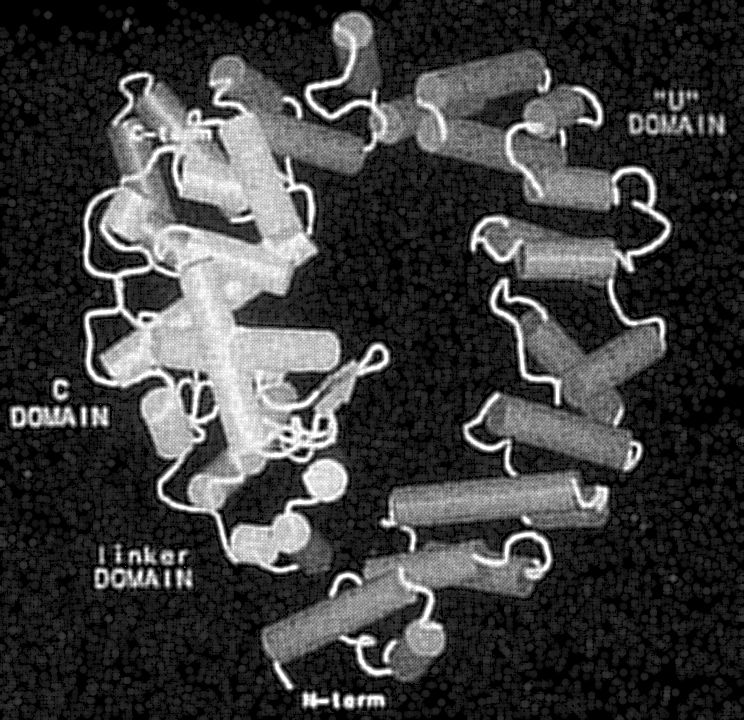 Superhelical doughnut of helices found in soluble lytic transglycosylase reported by A. M. Thunnissen (The Netherlands) in the first of two sessions on Hot Structures (03.08) in the Macromolecular Field.
Superhelical doughnut of helices found in soluble lytic transglycosylase reported by A. M. Thunnissen (The Netherlands) in the first of two sessions on Hot Structures (03.08) in the Macromolecular Field.
In his plenary lecture, Michael Rossmann described research in Virus Structure and Virus Infectivity (3.02) as a battle between the variability of pathogens and the ingenuity of scientists. The elucidation of the binding of drugs to the common cold virus demonstrates the importance of combining electron microscopy, synchrotron radiation, and X-ray diffraction in macromolecular structure determination. A microsymposium on Viruses (3.02) featured studies of new families of viruses, the use of structural results in drug design, and the synergy of combining cryo electron microscopy and X-ray crystallography. Subgroups of Theiler's virus that cause acute and persistent disease were described by M. Luo (USA). Studies of viruses from both subgroups provide insight into the structural basis for behavioral differences. Structures of foot and mouth disease virus from three serotypes (S. Curry, UK) illustrate antigenic variations and explain why immune response against one serotype does not protect against others. The antigenic loops on the surface of specific serotypes tend to be "pinned" into a fixed conformation by hydrophobic interactions. The structure of a complex of type B neuraminidase with sialic acid revealed that the bound sugar did not contain an 02 atom indicating that the enzyme had catalyzed the breakdown of the sialic acid to a stable transition state species or an inhibitor (I. C. White, USA). Experimental results favored the former conclusion, since the sugar appeared to be in the half-chair conformation. Compared to other Ig superfamily domains, the C'-C" loop of CD4, the cellular receptor attacked by the AIDS virus, is uniquely displaced from the body of the domain. This conformational feature appears to be essential for recognition by gp120 on HIV (J.-H. Wang, USA). D. I. Stewart (UK) described a family of human and animal virus with over twice the diameter of picornaviruses. X-ray and EM studies revealed that 780 copies of a protein named VP7 constitute the stable core of the viral capsid. The structure suggests how such massive assemblies might be formed with high fidelity by heterophilic and heomophilic interactions. Chair D. Stuart (UK)
In her plenary lecture on the Crystallography of Ribosomes (3.03), Ada Yonath (Israel), presented a status report on the progress made by her research team. In addition to describing the exhilaration associated with progress on this spectacular project, she discussed the frustrations that accompanied an undertaking that few sane people would attempt. "Sometimes it's depressing. Sometimes we're tempted to give up, but the excitement of discovery and the challenge keeps us going." Session Chair P. Codding (Canada) lauded Yonath's strategic use of a wide array of crystallographic. techniques and reasoning (metal atom cluster, MAD phasing, maximum entropy, direct methods, synchrotron radiation, cryocrystallography, etc.) in pursuing her sisyphean goal.
Structural, catalytic, and redox functions performed by metals and modulated by the protein environment were the subject of six presentations in the Metalloproteins (3.04) microsymposium. The use of synchrotron radiation, area detectors, and molecular biology have made a significant impact on the level of understanding we are now able to achieve. The binding of O2 to the copper pair in the 72 Kd subunit of hemocyanin not only confirmed model compound studies, but together with studies of two different deoxygenated forms shows that there are R and T states associated with this important O2 carrier (K. Magnus, USA). The ternary complex of three members of an electron transfer chain, methylamine dehydrogenase, amicyanin, and cytochrome C551 reported by L. Chen (USA), revealed plausible electron transfer pathways between the members of the complex. The pathway between NADH and amicyanin had been seen before in a complex of the two. However, the amicyanin cytochome C551 path was completely unanticipated. Moreover, a cytochrome-cytochrome contact resembles an interaction involving an exposed heme edge once predicated to be important to function. The critical role multiwavelength synchrotron data played in studying the nitrogenase MoFe protein was described in the exciting talk by J. Bolin (USA), who convincingly showed that the cubane-like iron clusters in the P center are more likely to be sulfur deficient in his protein rather than have an S-S bridge as reported by another group. Multi-wavelength experiments were also used to identify, the Mo, Fe, and S positions. The power of site directed mutagenesis studies when accompanied by structure determination was amply illustrated by the last three talks. In ribonucleotide reductase replacement of a tyrosine with a phenylaline turned the protein into a monooxygenase (P. Norland, Sweden), the functional role of Trp-191 and nearby residues in cytochrome C peroxidase was delineated (J. Karut, USA) and the influence of mutation of peptide residues remote from the metal binding site upon metal specificity of glucose isomerase was illustrated (J. Janin, France). Chair E. Adman
The first X-ray crystal structure analysis of a catalytic antibody, an enzyme with esterase activity was the subject of an exciting presentation by M. Knossow (France) in a microsymposium on Catalytic Mechanism of Hydrolysis (3.07).
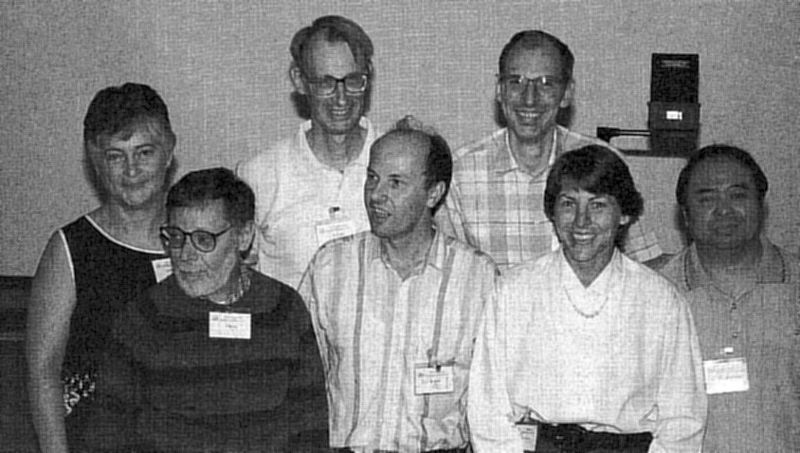 Speakers from the microsymposium on Enzymes (3.05) (front row), J. Kraut (USA), J. Janin (France), C. Pelletier (USA), D. C. Wang (PRC) (back row), O. Herzberg (USA), W. Hol (USA), B. Dijkstra (The Netherlands).
Speakers from the microsymposium on Enzymes (3.05) (front row), J. Kraut (USA), J. Janin (France), C. Pelletier (USA), D. C. Wang (PRC) (back row), O. Herzberg (USA), W. Hol (USA), B. Dijkstra (The Netherlands).
The six oral presentations and 35 posters assembled under this topic of Enzymes (3.05) show how powerful the combined application of site directed mutagenesis, biochemical probes, and crystallographic structure determination can be in defining catalytic mechanisms. Mutating a single tryptophan residue on the electron transfer pathway between cytochrome C and cytochrome C peroxidase in the X-ray structure of the complex (Pelletier, USA) was found to be fatal to the electron transfer process - and to the theoretical calculations that predict that an alternative pathway should dominate. X-ray diffraction can be used to follow a catalytic mechanism, but no "X-ray movie" is required in the case of haloalkane dehalogenase, an enzyme that detoxifies chlorinated compounds. In this case, intermediates can be made stable for sufficient periods of time just by playing with pH and temperature (Dijkstra, Holland). Ingenuity and perseverance are the key to success, in this and in many more complex systems such as 2-oxoacid dehydrogenase, an enzyme complex that approaches the ribosome in size, and which is patiently being dissected by the group of W. Hol in Groningen and Seattle. Chair J. Janin (France)
Highlights of the session on Protein Saccharide Interactions (3.06) were presentations concerning the observed flexibility in the quaternary structures of legume lectins (Vijayan, India), the mechanism of active phosphorylase achieved with time-resolved Laue techniques (L. N. Johnson, UK), the interactions of O-linked saccharide with residues in the active site of lignin peroxidase (Piontek, Switzerland), and the substitution of Cadmium for metal co factors to permit phase determination (J. R. Helliwell, UK). Session chair H.M. Einspahr (USA) cited progress in methods of incorporating carbohydrates into crystal structures and imaging carbohydrate-protein interactions as being particularly noteworthy.
 "Moonlight," the spellbinding dance executed by Yang Liping, electrified the audience at the opening ceremony of the IUCr Congress on Aug. 21.
"Moonlight," the spellbinding dance executed by Yang Liping, electrified the audience at the opening ceremony of the IUCr Congress on Aug. 21.
Drug structure and design
The highlights of the microsymposium on the Biological Activity of Peptides, Drugs, and Hormones (4.01) were a discussion of crystallization and analysis of transmembrane pore and channel forms of gramicidin A (B.A. Wallace, UK), the elucidation of common structural features that may account for similar biological activities of hypoglycemic drugs of very dissimilar composition (P. Luger, Germany), and a brilliant presentation concerning general rules for designing peptides with desired conformations by T. P. Singh (India). Singh illustrated that dehydro derivatives of amino acids have characteristic effects upon polypeptide conformations, that a polypeptide composed of alternating dehydro derivatives such as Aib will almost invariably form 310 helixes, and how this information might be used to control the conformations of potential trypsin inhibitors.
An entire microsymposium on HIV Proteins and Drug Design (5.02) was devoted to the primary targets of drugs which combat human immunodeficiency virus (HIV),these targets included the HIV proteinase (K. Appelt, USA), the reverse transcriptase (Wang, USA; J. Ding, USA; and R. M. Esnouf, UK); and the T-cell receptors, CD4 and CD8 (W. Hendrickson, USA).
Organic and inorganic crystallography
Quantitative information provided by systematic analysis of Molecular Interactions in Organic Crystals (6.01) provided insight into the details of hydrogen bonding (V. Bertolasi, Italy), the nature of ligand-protein interactions (G. Klebe, Germany), and the characterization of molecular association in sugars (C. Andre and J. Kopf, Germany). J. Bernstein (Israel) described the development and application of graph theory popularized by M. Etter to the design of crystalline complexes of predictable organization and properties. I. Goldberg (Israel) described porphyrin based inclusion compounds designed to capture specific molecules on the basis of shape and stereochemistry.
In his plenary lecture entitled Recognition in Supramolecular Structures (7.01), W. Saenger (Germany) described the rapid expansion in the field of supramolecular structures and the critical role played by crystallographic analysis in the design of special purpose materials. Saenger reviewed the growth of the field from simple oligoethers through cyclodextrin complexes to multi-component systems. The elaborate helical constructs produced by the team of Nobel Laureate J.M. Lehn are among the most ingenious thus far devised.
Recent advances presented in the microsymposium on Metal Clusters and Metal Coordination Analysis (7.02) demonstrate the ability of X-ray analysis to reveal the arrangement of metal clusters that could not be predicted or otherwise determined. The highlight of the session was a time-resolved study of a racemic to chiral transformation in crystals of cobaloxime (Y. Ohashi, Japan). Other presentations concerned models for metals in metalloenzymes and correlation of structures with chemical reactivity and homogeneous catalysis. Chair Yu. Struchkov (Russia)
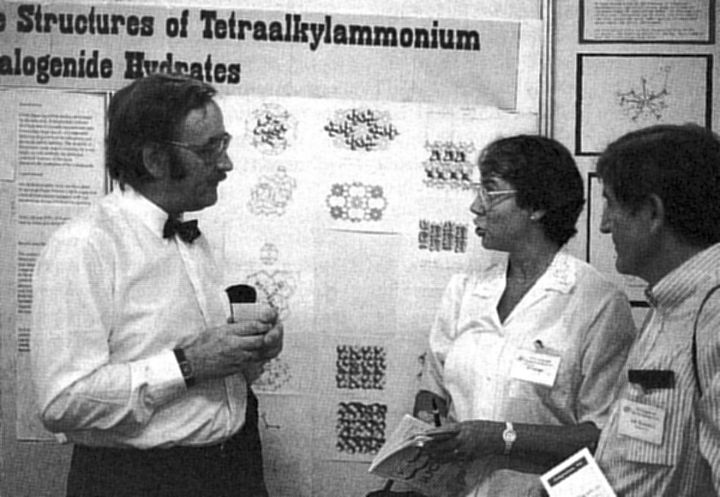 Ingeborg Csoregh (Sweden) and Luigi Nassimbeni (South Africa) engage Janus Lipkowski (Poland) before his poster in an intense discussion about complexes (or a complex discussion about intensity).
Ingeborg Csoregh (Sweden) and Luigi Nassimbeni (South Africa) engage Janus Lipkowski (Poland) before his poster in an intense discussion about complexes (or a complex discussion about intensity).
The session on Inorganic Crystal Chemistry (8.01) opened with general talks by F. Liebau (Germany) and I. D. Brown (Canada) on how inorganic structures could be classified and their structures interpreted in chemical terms. The next three papers addressed some of the complexities of inorganic structures - superstructure (A. D. Rae, Australia), occupational disorder (F. Marumo, Japan), and positional order and phase transformations (K. Lukaszewicz, Poland). P. Coppens (USA) and R. J. Cernik (UK) discussed the advantages of combining traditional X-ray diffraction with other techniques (X-ray spectroscopy, electron and neutron diffraction, and NMR). Finally P. A. Thomas (UK) pointed out that physical properties, such as refractive index and electro-optical coefficients, could be predicted if a structure is correctly known.
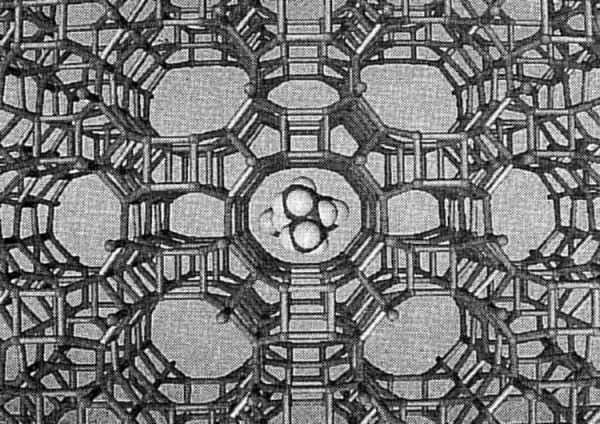 Computer graphic representation of isopropyl naphthalene sorbed on a zeolite (C. Freeman, BIOSYM Technologies, USA).
Computer graphic representation of isopropyl naphthalene sorbed on a zeolite (C. Freeman, BIOSYM Technologies, USA).
The availability of high quality computer graphics enhances the interpretation and presentation of the results of computer modeling studies. Highlights of the microsymposium on Computer Simulation of Inorganic Crystal Structure (9.01) included the successful use by C.M. Freeman (USA) of simulated annealing/energy minimization techniques in accurately modeling crystal structures and the simulation by J. S. Tse, Y. LePage, and D. D. Klug (Canada) of the high pressure amorphization of SiO2 and AlPO4 which has assisted the interpretation of the complex structural changes accompanying this process. Routine analysis will soon be available for the prediction of structure with little input of experimental data. Moreover, the techniques are being used increasingly for the investigation of complex processes such as the sorption of molecules within solids, surface structures and reactions, and pressure induced structural changes. Chair, R. Catlow (UK)
Materials research
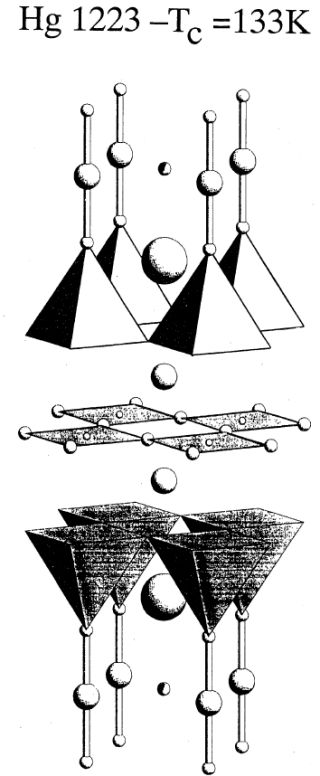 HgBa2Ca2Cu3O4+δ, an exciting new type of high temperature superconductor reported by E. Antipov (Russia).
HgBa2Ca2Cu3O4+δ, an exciting new type of high temperature superconductor reported by E. Antipov (Russia).
A variety of microsymposia and poster sessions were of particular interest to Materials Science (8.00) scientists. The materials of interest covered a gamut from electro-optical compounds and bulk and thin-film semiconductors to polymers, zeolites, non-stoichiometric ceramics, and oxide superconductors. There were several sessions on new developments in techniques for materials characterization: time-resolved studies of, for example, reaction kinetics, study of surfaces and interfaces through reflectometry, and characterization of defects, microstructure, and texture with the aid of electron microscopy. Numerous presentations discussed the preparation and crystal growth of materials with useful physical properties. One microsymposium was devoted entirely to aspects of industrial crystallography. The industries varied from the chemical and pharmaceutical to several materials-related activities.
H. G. Preismeyer (Germany) reviewed the use of neutron diffraction to measure stress fields in industrial metals and ceramics. G. Kostorz (Switzerland) discussed the application of small-angle scattering to the study of defect agglomeration and phase separation. I. C. Bassignana and D.A. Macquistan (Canada) described a method based on asymmetric-crystal topography for routine on-line screening of semiconductor substrate wafers. An engaging talk on the use of powder diffraction in patents was presented by S. E. Tarling (UK). Recent progress in the crystal chemistry of high-Tc oxide superconductors was described by presentations from all over the world. In one of the main lectures, V. N. Molchanov (Russia) reviewed understanding of the relations between the superconducting transition and disorder, modulations, microstructure, and twinning in this complex family of materials. Six oral presentations in a microsymposium and well over two dozen poster presentations ranged from the search for new superconductors (E. V. Antipov, Russia) to the high resolution electron microscopy of extended defects (J. Galy, France). Defect structures of other materials were elucidated in other sessions. J. Cowley (USA) described progress in the use of electron microscopy and electron nanodiffraction in the study of disordered solids. In the same microsymposium on disordered materials, T.R. Welberry (Austraila) and F. Frey and H. Boysen (Germany) discussed diffuse scattering and Bragg scattering studies of disorder in the important ceramic oxides ZrO2, CeO2, and LiNbO3. Other uses of electron diffraction in materials science appeared in the Microsymposium on Electron Microscopy of Defects, Microstructure, and Texture. X. F. Duan and co-workers (PRC), employed convergent-beam electron diffraction to study strained-layer semiconductor superlattices. A recurring problem in materials characterization is the use of powder diffraction in the quantitative analysis of multiple mixtures. A review of recent developments and the present status of this problem was provided by H. Toraya (Japan) and J. Fiala (Czech Republic). Details of analysis via the Rietveld method and by the two-stage decomposition method were provided by J. Schneider (Germany) and G. Will (Germany), respectively. That these examples constitute but a very small fraction of the presentations and sessions dealing with characterization and structure-property relations in materials is an indication of the rich and varied relevance of the IUCr Congress to materials science. [B. J. Wuensch, reporter at large, taken from the ACA Newsletter, Sept. 1993].
The stunningly eloquent and brilliantly illustrated presentation by R. Nesper (Switzerland) entitled Internal Surfaces as Order Principles in Solids (8.01), set a new standard for plenary lectures. With dual slide projectors, Nesper drew insightful comparisons between superstrings and the origin of life, soap bubbles and foamy nickel, the architecture of the temple of heaven and geometry of optimally curved surfaces, the wings of butterflies and cell structure, a phase diagram and a graph of stock market prices, and the arms of an Indian Goddess and the d-orbitals of transition metals. After this bravura introduction, he settled into a detailed analysis of surfaces within crystals as defined by the distribution of molecules, atoms, charges, and other entities that one may wish to define and partition. Nesper followed his dual slide presentation with a magnificent video illustrating these internal surfaces. He discussed the relationship between inner surfaces in crystals and the intrinsic properties of matter and asserted that nature strives for optimal forms and optimal forms are governed by the first surfaces.
In his plenary lecture entitled Crystal Structure and Superconducting Transition of High-Tc Materials (10.2), V.N. Molchanov, (Russia) meticulously characterized a structural discontinuity of Tc-based superconductors at their superconducting temperature.· The microsymposium on Superconducting Materials (10.1) addressed major trends in present research on the topic, gaining a better understanding of structures and phase diagrams, and searching for new compounds. S. Amelinckx (Belgium) showed how electron microscopy can be used to get insight into complicated Co or Ga substituted compounds. F. Izumi Qapan) demonstrated the application of powder neutron diffraction to the study of high-Tc compounds. R. Harlow (USA) reported progress in the study of phase diagrams of doped La2 CuO 4 using powder synchrotron X-ray diffraction, work of great interest for the theoretical understanding of high-Tc superconductivity. On the new compounds "front" W.J. Zhu (PRC) reported on new borate compounds, with borate groups substituting for chain copper in a 123 structure. The most remarkable presentation concerned a new homologous series ofHg containing compounds with structures similar to those of the single Tl layer compounds (E. Antipov, Russia). The so-called Hg-1223 compound yields a record Tc of 133 K, and this series provides a new opportunity to study the evolution of the superconductivity properties versus various structural/chemical features (cell parameters, oxygen content, etc.). Chair P. Bordet (France).
In his plenary lecture on Fullerenes (10.1), W. I. F. David (UK) discussed the use of powder and single crystal data to follow the variation in the structure over 180° temperature range from the high-temperature disorder phase with high spin characteristics through an order-disorder transition at 260 K to an orientational glass having no spin at 86 K. The microsymposium on Fullerenes (10.2) covered aspects of research ranging from structure determination to chemical reactivity. Detailed structures of pure C60 at various temperatures and of co-crystals of C60 with other molecules were discussed. In all of them, C60 is orientationally disordered. The probability density function of residual orientational order in pure C60 at room temperature was presented by P. Wochner (USA) and H.-B. Bürgi (Switzerland). High Resolution Electron Microscopy (HREM) was successfully applied by S. Amelinckx (Belgium) to study stacking faults, twin domains, dislocations in C60 crystals, and phase transitions of C70 crystals. Transformations of C60 under non-hydrostatic pressures of 20 GPa to amorphous graphite-like or diamond-like materials, depending on temperature were discussed by J. L. Hodeau (France), and R. M. Walton (UK) presented a review of the known derivatives of C60, C60 polymers chemistry, and the reactivity of C70.
A microsymposium on Aspects of Industrial Crystallography (20.01) surveyed techniques used to analyze, test, and predict properties of a broad range of materials. S. E. Tarling (UK) discussed the increased use of X-ray powder diffraction data on drug polymorphism in high court patent disputes. Presentations on neutron diffraction studies of stress in steel bars (H. G. Priesmeyer, Germany) and the examination of defect structures in semiconductor boules (I. C. Bassignana, Canada) were illustrative of full scale industrial applications. Other industrial materials discussed in the session included zirconia ceramics (X. Turrillas, UK), porous silicon (T. Turrillas, UK) and pharmaceuticals (T. Skarzynski, UK).
Surfaces, glasses, polymers, and topography
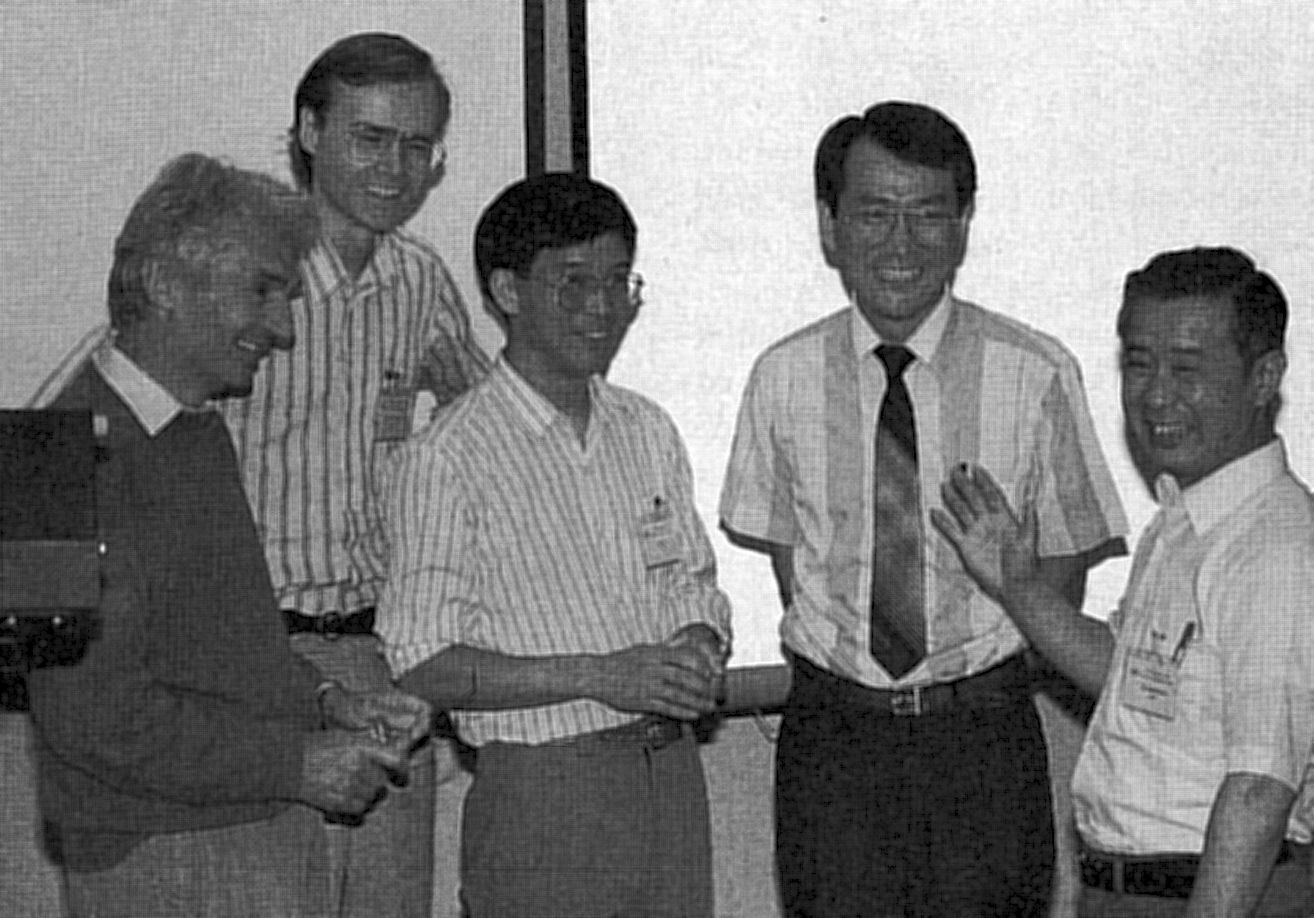 Chairman H. Hashizume, Japan, (right) gives strict instructions to speakers in his microsymposium on Surface Interface Structures (11.01) to keep to time. The speakers (from left) H. Schultz (Germany), R.G. Van Shilfoot (Germany), J.R. Lu (PRC), and H. You (USA) do not seem to be taking him seriously.
Chairman H. Hashizume, Japan, (right) gives strict instructions to speakers in his microsymposium on Surface Interface Structures (11.01) to keep to time. The speakers (from left) H. Schultz (Germany), R.G. Van Shilfoot (Germany), J.R. Lu (PRC), and H. You (USA) do not seem to be taking him seriously.
In his plenary lecture entitled Neutron and X-Ray Reflectometry of Surfaces and Interfaces (11.01), R.K. Thomas (UK) showed how neutron and X-ray specular reflections at grazing incidence give information about structure normal to an interface with examples from a Langmuir-Blodgett multilayer. The microsymposium on Surface and Interface Structures (11.01) marked the growing popularity of the technique of glancing incidence X-ray diffractometry/reflectometry and featured impressive electron density maps of InSb surfaces presented by H. Schultz (Germany).
Highlights of the microsymposium on Quasicrystals and Incommensurate Crystal Structures (12.01) were a review of common features of recently determined decagonal structures (W. Steurer, Germany) and a particularly lucid description of superstructures in terms of atomic modulations by R. Withers (Australia).
Improvements in experimental and theoretical techniques are leading to a better understanding of the nature of Disordered Materials (12.02). Examination of highly disordered particles by electron nano-diffraction, quantitative interpretations of three-dimensional X-ray diffuse scattering, and the inclusion of dynamical effects (motion and excitation) in the interpretation of defect studies, were among the highlights of the microsymposium on disordered materials chaired by H. Jagodzinski (Germany).
A microsymposium on Glasses and Polymers (12.03) illustrated the combined use of fiber diffraction, molecular modeling, and crystal packing considerations to determine the structure of polymers. W. Fuller (UK) presented results of a time-resolved X-ray diffraction study of polymers around the glass transition based upon synchrotron data.
 Cartoon illustrating a typical application of X-ray standing waves in the determination of preferentional site absorption. The last arriving alkali atom is looking for free space on a Si (111) 7×7 reconstructed surface. From a poster by S. Lagomarsino (Italy) with a drawing by R. Carluccio.
Cartoon illustrating a typical application of X-ray standing waves in the determination of preferentional site absorption. The last arriving alkali atom is looking for free space on a Si (111) 7×7 reconstructed surface. From a poster by S. Lagomarsino (Italy) with a drawing by R. Carluccio.
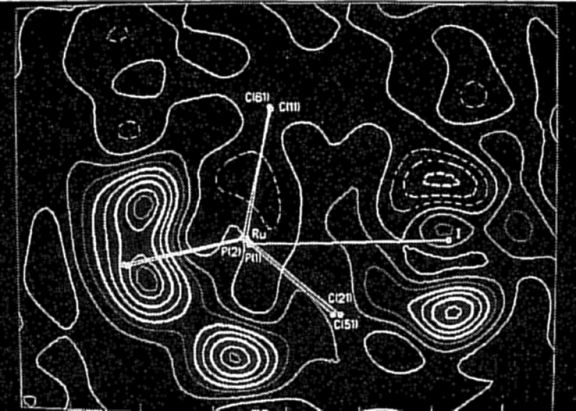 A residual electron density map of RuH(η2-H2) I (PCy3)2 showing the location of hydride ions presented by F. J. Lahoz (Spain) was a subject of some debate.
A residual electron density map of RuH(η2-H2) I (PCy3)2 showing the location of hydride ions presented by F. J. Lahoz (Spain) was a subject of some debate.
 A residual electron density map of RuH(η2-H2) I (PCy3)2 showing the location of hydride ions presented by F. J. Lahoz (Spain) was a subject of some debate.
A residual electron density map of RuH(η2-H2) I (PCy3)2 showing the location of hydride ions presented by F. J. Lahoz (Spain) was a subject of some debate.
 Double crystal topograph of silicon lamellae of rhombic shape grown by liquid phase epitaxy over silicon dioxide. The growth started at seed windows etched in the oxide covering a silicon wafer. The reflection of 'L' of the lamella itself originates at the position 'S' (Jenichen, Kohler, Sauser, Nagel).
Double crystal topograph of silicon lamellae of rhombic shape grown by liquid phase epitaxy over silicon dioxide. The growth started at seed windows etched in the oxide covering a silicon wafer. The reflection of 'L' of the lamella itself originates at the position 'S' (Jenichen, Kohler, Sauser, Nagel).
The chairman of the session on Characterization of Materials by Topography and High Resolution Diffractometry (13.02) J. Baruchel noted the increasing importance of "real time" physical investigations (phase transitions, crystal growth, domains, and defects movement of high quality single crystals). T. Ishikawa (Japan) reported investigations using plane wave topography. Asymmetrically cut monochromators having a beam with very low divergence (8 × 10-3 s of arc) were used to study distortion of GaAs plates and dislocations in perfect Si crystals. By setting an analyzer in the beam diffracted by the sample, angle resolved plane wave topography led to an equilattice spacing map of the sample. Diffraction topography and total reflection allowed the observation of defects which penetrated the Si substrate from the deposited Al layer after annealing. P. Fewster (UK) emphasized the importance of considering the whole diffraction pattern, when characterizing defects. Using the high dynamic range (107) "diffuse scattering topography", even the best Si and Ge crystals show surface damage, dislocations, and point defects. Synchrotron radiation in situ topographic observation of the phase transition and ferroelastic domain structure evolution in lanthanum pentaphosphate revealed that there is a minimum in the number of domain walls (Z. Hu, PRC). J. Baruchel (France) reported "real time" synchrotron radiation investigations of multiplication in ice, cellular and dendritic growth of Al-Cu alloys, and phase coexistence at a magnetic triple point in MnP. Third generation synchrotron sources offer potential for reduced exposure time, enhanced resolution, and improved sensitivity to small distortions. M. Servidori (Italy) compared the information one can extract from the different measuring modes in double and triple crystal diffractometry of dislocation loops in irradiated silicon. R. Köhler (Germany) provided several examples of complementarity of topography and diffractometry for the investigation of layers and multilayers including Si lamella over SiO2. Chair, J. Baruchel (France)
Crystallization
A microsymposium on Crystallization of Biological Macromolecules (15.01) provided a review of current research in the field. A wide variety of physical methods (SAXS, SANS, light scattering) are being used to monitor details of crystal growth mechanisms and broad range of chemicals (solvents, detergents) and physical conditions (response surfaces, etc.) are being tested in an effort to produce crystals with higher resolution diffraction. Debates rage concerning the merit of microgravity and the choice of "model" proteins. With regard to the latter, physicists prefer to work with well defined proteins (such as Lysozyme) whereas biologists prefer to focus on new challenges such as membrane bound proteins. Chair A. Ducruix (France)
The most significant new results reported in the microsymposium on Symmetry of Crystals and Quasicrystals (17.01) included application of high order moments to the characterization of three-dimensional diffraction patterns (S. Cerrini, Italy), complete characterization of crystallographic five-dimensional point groups (R. Veysseyre, France), application of the theorem of Polya to periodic color rings of a net (J. S. Rutherford, South Africa) and a discourse on new approaches to representations of space groups and subperiodic groups (V. Kopsky, Fiji). Chair Y. Billiet (Niger)
Resources
 Happiness is a bigger, better, more useful database and if you keep smiling, the pain goes away. From left, A. D. Mighell (NIST, Materials), T. Koetzle (Protein Data Bank), F. Allen (Cambridge Structural Database), N. Spadaccini and S. Hall (STAR files), T. Maslen (Chair, Session 18.01), and R. Jenkins (Powder Data).
Happiness is a bigger, better, more useful database and if you keep smiling, the pain goes away. From left, A. D. Mighell (NIST, Materials), T. Koetzle (Protein Data Bank), F. Allen (Cambridge Structural Database), N. Spadaccini and S. Hall (STAR files), T. Maslen (Chair, Session 18.01), and R. Jenkins (Powder Data).
Presentations in a microsymposium on Crystallographic Databases (18.01) included discussion of the challenges of coping with the demands of rapidly expanding databases, combining data derived from traditional techniques with that from new sources such as synchrotron radiation, how to incorporate data on chemical and other physical properties into databases, and how to improve structural classification and incorporate graphical display techniques. Chair E.N. Maslen (Australia)
An open meeting on Crystallographic Teaching (19.01) chaired by J. P. Glusker (USA) and Z. Y. Zhou drew an overflow crowd. P. Lindley (UK) discussed the impact of synchrotron radiation upon crystallographic teaching. He described the apparatus, its application to macromolecular crystallography and powder diffraction, Laue methods, image plates, the problems of small crystals and large unit cells, and the uses of anomalous scattering. He also discussed the use of time-resolved data collection to follow chemical reactions and the application of the Rietveld method to structures that do not crystallize well. H. von Philipsborn (Germany) provided a detailed description of radiation standards and the importance of observing safety precautions during X-ray diffraction data collection. The Visiting Professor Program of the IUCr Teaching Commission was described by W. T. Robinson (New Zealand) who has first-hand experience as a Visiting Professor. Then followed three talks on methods. H. Schenk (The Netherlands) gave a lively talk on how to teach direct methods of phase determination with an illustration of the crystal structure of benzene. W. Hendrickson (USA) described phasing methods for proteins and J. Glusker (USA) described diagrammatic methods of describing crystal structure determinations in terms of Fourier transforms. The IUCr Teaching Commission Pamphlet Program was described in a poster session.
Non-ambient conditions and phase transitions
A session on High Pressure Techniques and Structure (21.01) revealed that more reliable intensity data obtained from imaging plates, synchrotron sources, and new pressure cells like the one developed by a team from Paris and Edinburgh, that successfully achieved 25 GPa pressure are allowing precise structure analysis of high pressure phases that could not be undertaken before. Chair Y. Fujii (Japan).
 Peking Ducks hanging out.
Peking Ducks hanging out.
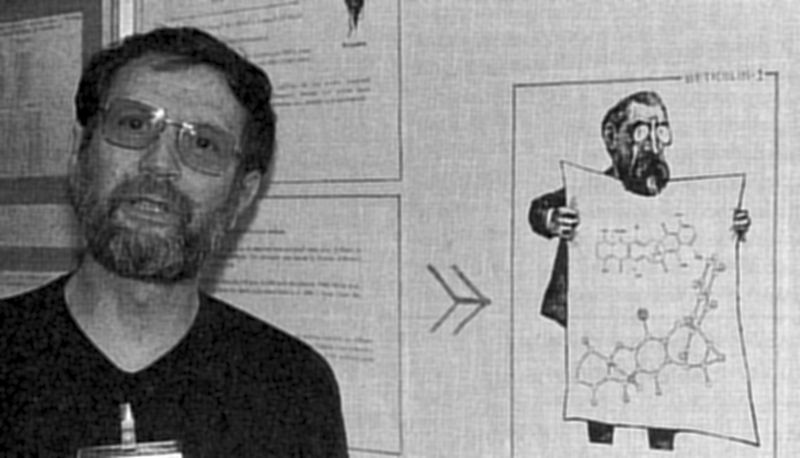 Life imitating art beside a poster describing novel toxins found in sugar beet fungus (A. Neuman et al., France).
Life imitating art beside a poster describing novel toxins found in sugar beet fungus (A. Neuman et al., France).
In the microsymposium on Low Temperature Crystallography (21.02) techniques for and the advantages of obtaining structure information at 10-20 K were surveyed. R. M. Ibberson (UK) showed that high resolution powder data gathered at 1.5 K can lead to an accuracy of positional and displacement parameters comparable to single crystal experiments with less beam time and smaller crystals. P. Luger (Germany) described routine X-ray single crystal experiments at around 20 K using a double stage He- cryostat on a diffractometer. These data sets have significant signal to background improvement with increasing sin θ/λ, so that high order refinement provides very accurate atomic parameters for charge density work. D. Mootz (Germany) reported on low-melting hydrates and hydrogen halide aducts. Novel bonding adducts of dimethyl acetylene and hydrogen chloride have been characterized for the first time. B. Figgis (Australia) discussed diffraction experiments with polarized neutrons on a series of transition metal complexes at 4 K. The data allowed covalence and spin polarization effects to be identified. X-ray topography experiments below 1 K at the Photon Factory were described by T. Nakajima (Japan). Investigating phase transitions of K3D(SO4)2, Y. Noda (Japan) presented a Weissenberg photograph exposed at 12 K using a new image plate technique. Diffraction experiments using different techniques (powder, X-ray, and neutron single crystal, synchrotron, topography) have been developed that allow studies at 1 K or lower. This allows the collection of high quality data sets and the study of structural properties only present at these temperatures.
The session on Phase Transitions in Crystals (21.03) focused upon theory and application to systems ranging from lipid membranes to metals and alloys. Landau theory and other conceptually simple macroscopically thermodynamic models are being applied to systems of increasing microscopic and structural complexity. Order-parameter coupling was a recurring topic with practical application in structure refinements (H. Boysen, Germany). The dynamic response of ferroelectrics to applied fields was discussed for liquid (W. Haase, Germany) as well as solid crystals (M. Suhara, Japan) with stunning exampies of complex Landau theory in combination with experiments. Internal and external stress fields (W. Schmahl, Germany; Suhara, Japan; Haase, Germany) and their crystallographic characterization by high Δd/d resolution data (A. Okazaki, Japan) were discussed. Close associations between nucleation theory (P. Hong, USA), the theory of order-parameter realization in domain walls (Ishibashi, Japan) and the spacial variation of the order-parameter characteristic for structures and phase transitions in incommensurate and quasi-crystalline systems (Suhara, Japan; Denoyer, France) are growing apparent. Many of the future challenges - in particular the actual link between the continuum and the structurally atomistic approach - occur in this field of space and time variation of order parameters at domain and phase boundaries. Contributions on the relation of chemical reactions to structural phase transitions in biological systems (Suezaki, Japan) and electrochemical cells (Depmeier, Germany) demonstrated the wide scope of in situ studies of "soft" reaction mechanisms in wet-chemical environments.


